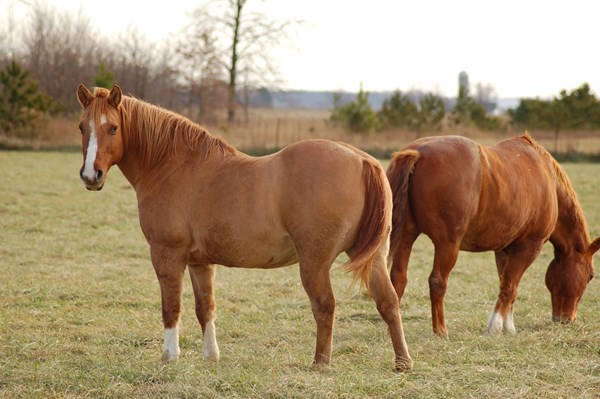 Credit: Thinkstock Want to keep weight under control and ward off metabolic problems? The best way is to add at least 30 minutes of exercise each day to your horse’s leisurely life.
Credit: Thinkstock Want to keep weight under control and ward off metabolic problems? The best way is to add at least 30 minutes of exercise each day to your horse’s leisurely life.Providing optimal nutrition for “air ferns,” those horses with incredibly efficient metabolisms, challenges even the most dedicated of horse owners. With clear focus on the goal–that is, weight control–most horse owners find a way to employ management tactics to keep the waistlines of their horses in check.
Five management tips for overweight horses:
1. Limit grazing. Sure, you’ve spent years and thousands of dollars preening your pastures to provide an abundance of best-quality forage, but full-out grazing on such plushness is counterproductive to calorie restriction. It is nearly impossible for a horse to lose weight, or even maintain it, when it has at its disposal a veritable (and verdant) smorgasbord.
Before you begin construction on a dreaded drylot, consider allowing short bouts of grazing a few times each day. “One or two hours of grazing once or twice a day provides horses with the chance to forage and frolic, two important keys to physical and mental well-being,” said Kathleen Crandell, PhD, a nutritionist for Kentucky Equine Research (KER).
Because overweight horses are prone to metabolic diseases, choose grazing times wisely, Crandell advised, ideally when sugar levels in pasture grasses are low, such as in the early-morning hours.
2. Choose concentrates conscientiously. What horse owner doesn’t love the smell of molasses that fills the air when the lid of the feed bin opens? However, many fleshy horses don’t need a heaping scoop of sweet feed.
“For overweight horses with low to moderate caloric requirements, feed selection should be centered on providing optimal vitamin and mineral nutrition, and this often translates to a well-formulated ration balancer or vitamin and mineral supplement,” said Crandell. Offering a fortified feed to overweight horses only compounds the pudge predicament, supplying way too much energy for optimal health.
If, by chance, a horse becomes engaged in a consistent exercise program, caloric requirements will creep up, and an all-forage diet may no longer work. In that case, a fully fortified concentrate should then be fed, especially if a horse drops weight quickly and or has difficulty maintaining moderate weight. “A horse’s diet should be considered dynamic; as the horse’s lifestyle changes, so too must its diet,” said Crandell.
(Horses on an all-forage diet should be fed a vitamin and mineral supplement to appropriately complete a diet, such as Micro-Max, developed by KER and available in the U.S.)
3. Select appropriate hay. Few horse owners mind shelling out shekels for quality hay. Quality, however, is a vague descriptor, as hay that’s suitable for a rowdy, gangly yearling is likely inappropriate (read: too many calories) for the confirmed air fern. Visions of premium-quality alfalfa (lucerne) or alfalfa-grass blends dancing in your head? Banish the thought! For podgy horses, lower your standards.
Consider hay that was baled later than ideal (a telltale sign: fully formed seedheads) or that is comprised of a mixture of common grasses rather than one or two predominant varieties. This type of hay contains less energy than primo hay, so it is most fitting for easy keepers. Even though the hay will be slightly less nutritious, it still should be free of dust, mold, foreign material and unusual odors.
4. Deploy the grazing muzzle.Yes, it makes him look like Hannibal Lecter, but it’s not about fashion, okay? It’s about his health! Using a grazing muzzle will allow a horse more time to roam, nip at grass, and socialize with peers. A good rule of thumb: a horse can double its time on pasture while wearing a grazing muzzle, as consumption is significantly reduced.
Extra care should be given to proper adjustment of the grazing muzzle. If fitted too tightly, rubs may develop, leading to open sores; if fitted too loosely, the horse will find a way to escape from the muzzle and go hog-wild on pasture.
5. Devise an exercise plan and stick to it. Want to keep weight under control and ward off metabolic problems? The best way is to add at least 30 minutes of exercise each day to your horse’s leisurely life. Bored with the riding routine? Mix up the type of work from day to day to keep the program exciting: longe one day, trail ride the next, then work in the arena on the third day. Take the horse for a swim, trot or lope in a horse-friendly park, take a lesson in a sport that’s new to you and your horse. The most important point is to elevate the horse’s heart rate for at least 30 minutes each day.
Article courtesy of Kentucky Equine Research. Visit equinews.com/newsletters to subscribe to The Weekly Feed, KER’s award-winning equine nutrition newsletter.


